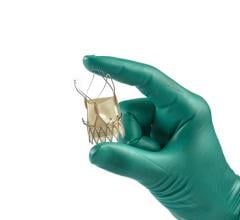September 27, 2011 — A team of physicians, engineers and materials scientists at Children's Hospital Boston and the Massachusetts Institute of Technology (MIT) have created cardiac patches, with cells all beating in time, that could someday help heart attack patients. The devices were created using nanotechnology and tiny gold wires.
As reported online by Nature Nanotechnology Sept. 25, the addition of gold wires to the engineered heart tissue makes it electrically conductive, potentially improving on existing cardiac patches. Such patches are starting to go into clinical trials for heart patients.
"If you don't have the gold nanowires, and you stimulate the cardiac patch with an electrode, the cells will beat only right where you're stimulating," says senior investigator Daniel Kohane, M.D., Ph.D., of the Laboratory for Biomaterials and Drug Delivery at Children's Hospital Boston. "With the nanowires, you see a lot of cells contracting together, even when the stimulation is far away. That shows the tissue is conducting."
After incubation, the patches studded with the gold nanowires were thicker and their heart muscle cells better organized. When stimulated with an electrical current, the cells produced a measurable spike in voltage, and electrical communication between adjacent bundles of cardiac cells was markedly improved. In contrast, only a negligible current passed through patches lacking the wires, and cells beat only in isolated clusters.
Kohane thinks the nanowire technology could be applied to the engineering of any electrically excitable tissue, including tissue in the brain and spinal cord. Gold was chosen as a material because it's a conductive material, easy to fabricate, scientists have a lot of experience with it, and the body tolerates it.
The wires are on average 30 nanometers thick and 2-3 microns long, just barely visible to the naked eye.
Since testing has so far been done only in cell cultures, the team is planning further experiments to see how well the cardiac patches function in live animal models; they also hope to get a better understanding of how exactly the nanowires are enhancing electrical signaling and contraction.
Kohane believes the gold fibers help because they're long enough to cross the scaffolding material holding the cells and may act as a barrier to electrical conduction. In addition, the experiments showed enhanced production of troponin I, a protein involved in muscle calcium binding and contraction, and connexin-43, a protein involved in electrical coupling between cells. Connexin-43 is believed to play a critical role in the development of the heart's architecture and in the synchronized contraction of the heart.
The National Institutes of Health (NIH) and the American Heart Association (AHA) funded the study. The paper's co-first authors were Tal Dvir, Ph.D., and Brian Timko, Ph.D., both of the department of chemical engineering, MIT, and the Laboratory for Biomaterials and Drug Delivery at Children's Hospital Boston.
For more information: http://vectorblog.org


 October 23, 2024
October 23, 2024 








